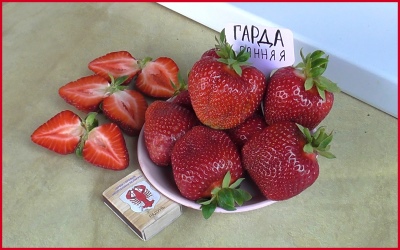
- Authors: Italy, CRA-FRF Institute and Verona Agricultural Testing Institute
- Name synonyms: Garda
- Taste: balanced, sweet and sour
- The size: very large
- Weight: up to 80 gr
- Yield rate: high
- Yield: more than 1 kg per bush
- Ripening terms: mid-late
- Advantages: good keeping quality, yields a harvest even in unfavorable weather
- disadvantages: the berry is somewhat shallower at the end of the harvest season
Garda is a strawberry variety developed jointly by the CRA-FRF and the Verona Agricultural Testing Institute in Italy. Garda adapts well to difficult conditions, and therefore quickly gained popularity among Russian gardeners.
Description of the variety
Garda has a bush of medium vigor, its height and width are 35-40 cm. The leaves grow densely, on each bush 2-4 peduncles are formed, on which ovaries and fruits are formed in large quantities. Flowers are medium in size, whiskers grow in small numbers.
Ripening terms
Garda is a medium-early ripening variety. The fruiting period occurs in June-August, repeated fruiting in autumn is not excluded.
Yield
The variety has a high yield. More than 1 kg of berries can be harvested from one bush. A feature of Garda is its ability to bring a good harvest even under unfavorable conditions, but it is worth considering that the fruits can become shallow at the end of the harvesting season.
Berries and their taste
The fruits are red in color, conical in shape and very large - their weight can reach 80 g. The taste of the berry is sweet and sour, balanced. The pulp is dense, which ensures good keeping quality and transportability, which means that the variety is suitable for industrial cultivation.
Growing features
The presented variety has good winter hardiness, and therefore it can be kept in the northern regions of Russia. It is allowed to plant bushes in greenhouse conditions.
For irrigation, it is advisable to bring a drip system, which will moisten the soil in doses. Excess moisture will negatively affect the taste of the berries, depriving it of sugar content. It is important to clear the area of weeds in a timely manner, as well as periodically trim the mustache so that the young rosettes do not take away the strength from the mother bush. The plant should not be kept in one place for more than 4 years.




Site selection and soil preparation
The Garda variety grows well in fertile soil. When choosing a site, give preference to sunny or slightly shaded places.
Planting can be done in April or October. When planting in spring, the site should be dug up and the roots of the predecessor plants should be eliminated. Highly acidified soil must be diluted with dolomite flour (0.5 kg per 1 m2). When planting in sandy loam soil, it is worth adding organic fertilizer - 1 bucket per 1 m2.

Pollination
The variety is characterized by a large amount of pollen, which ensures good natural fertility. If the plant is planted in a greenhouse, a fan or brush can be used for pollination.
Top dressing
You need to fertilize the plant from the second year of life. Feeding a crop consists of several stages.
With the arrival of spring, nitrogen compounds are used, for example, rotted manure. To do this, 2-3 kg of raw materials are diluted in a bucket of water and insisted for a couple of hours.
Potash mixtures will be relevant before flowering. They are prepared by combining 1 tbsp. l. potassium salt or nitroammofoska with 10 liters of water.
At the time of fruit ovary, foliar dressing with boron is suitable. To prepare the composition, mix 2 g of boric acid and 10 liters of water. The resulting solution is sprayed with bushes.
After harvesting, wood ash, used as fertilizer, will become appropriate.

One of the important techniques in strawberry care is feeding. Regular fertilization guarantees a rich harvest. There are several different ways to feed strawberries, and each of them is designed for a specific period of plant development. During flowering, fruiting and after it, feeding should be different.
Frost resistance and the need for shelter
The winter hardiness of Garda strawberries is limited to a temperature of -17 degrees, so when grown in the northern regions, you should take care of the plant's insulation. In preparation for winter, you need to cut off old leaves, treat the area with a copper-containing product, mulch the garden bed or cover it with spruce branches.

Diseases and pests
The Garda variety cannot boast of high immunity. It is easily affected by gray mold, powdery mildew, anthracnose. For prevention, treat the area with a solution of Bordeaux liquid in spring and autumn. Correctly applied top dressing also has a positive effect on the immunity of the culture. The plant should also be protected from insects. Marigolds planted nearby will help against slugs, and an infusion of celandine will save from aphids.

Strawberries are often subject to many dangerous diseases that can seriously undermine its condition. Among the most common are powdery mildew, gray mold, brown spot, anthracnose, and verticillosis.Before buying a variety, you need to inquire about its disease resistance.
Reproduction
Breeding the Garda variety is not so easy due to the small number of mustaches. In general, the plant is bred with rosettes or dividing the bush. For reproduction, choose first and second order sockets, and cut off the rest. In order for the seedlings to adapt well to new conditions, root them in plastic containers.
When propagating by dividing the bush, give preference to three-year-old specimens with a well-developed root system, which can be divided into parts.



















































































